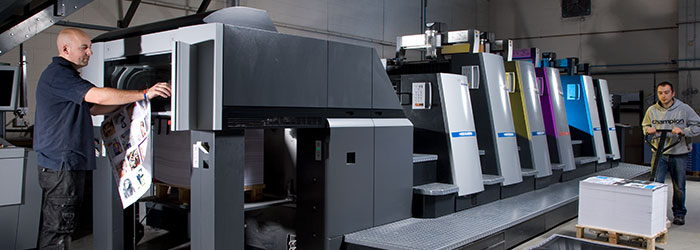A Comprehensive Guide to Recognizing Litho Printing Strategies
The globe of litho printing, a strategy originating from the late 18th century, is an interesting mix of background, innovation, art and science. This comprehensive guide will certainly decipher the intricacies of this printing technique, from the make-up of litho inks to the challenges faced in modern applications. As we venture right into the intricacies of lithography, the value of automation and sustainability in ensuring its future importance becomes progressively clear. Stay with us as we journey into the captivating realm of litho printing.
The Historical Advancement of Litho Printing
The historical trajectory of litho printing, an essential innovation in the realm of interaction, is an exciting story of human resourcefulness. Birthed in the late 18th century by Alois Senefelder, this method was initially an affordable method of publishing theatrical jobs. Lithography, originated from the Greek words for 'stone' and 'to create', utilized a smooth stone surface area to transfer pictures onto paper. The procedure advanced with the arrival of the rotary press, which greatly increased efficiency (litho printing). In the 20th century, the innovation of balanced out lithography reinvented the industry, enabling automation of top notch prints. Each phase of litho printing's evolution showcases mankind's ruthless pursuit of efficiency and high quality in visual communication.
Deciphering the Scientific Research Behind Litho Printing Inks
Progressing in the exploration of litho printing strategies, the emphasis now changes to the science behind litho printing inks. The make-up of these inks, their drying procedure, and color mixing methods form the foundation of this complex art form. Comprehending these aspects is vital to mastering the craft and attaining the preferred print outcomes.
Composition of Litho Inks
In lithographic printing, the fundamental function of litho inks can not be overstated. Pigments, the color-providing aspects, are carefully ground fragments put on hold in the lorry, a fluid that brings the pigment onto the printing surface. Each element plays a critical component in the final print's top quality, making the precise solution of litho inks a complex scientific research.
Ink Drying Refine
From the structure of litho inks, focus turns to the interesting procedure of ink drying. The drying out process is crucial, as it impacts the last print's quality and long life. Two main methods are utilized in litho printing: oxidative drying out and absorption. Oxidative drying out includes the ink responding with oxygen in the air to develop a hard, completely dry movie. This technique supplies a resilient surface, however can be slower compared to absorption. Absorption, on the other hand, entails the ink leaking right into the paper fibers, which is a much faster process however can lead to much less lively colors. The choice between these approaches is reliant upon elements such as print rate requirements, the paper type made use of, and the wanted finish.
Shade Combining Techniques
While the drying out process plays an essential duty in litho printing, the scientific research of color blending techniques holds equivalent significance. The scientific research behind litho printing inks likewise takes right into account the openness of the ink, which impacts just how colors overlay and mix.
The Art and Layout Components in Litho Printing
Litho printing takes a breath life into art and style through its unique aspects. Litho printing fits a range of shades, allowing artists to develop dynamic and vibrant prints. This mix of precision and convenience makes litho printing a preferred choice for lots of musicians and designers.
Modern Applications of Litho Printing Methods
Litho printing strategies have discovered comprehensive usage in the contemporary business sector. Its impact and value remain to grow with the development of brand-new technologies and technologies in the field. This section will explore these contemporary applications and the transformative role they play in the printing sector.
Commercial Litho Printing Makes Use Of
Litho printing stays an important part of the commercial field. High-volume printing tasks, such as the production of publications, papers, and product packaging, count on litho printing for its capability to supply premium photo quality and cost effectiveness. Litho printing also provides a wide color spectrum, superior to that of digital printing.
Advancements in Litho Printing
Pushing the limits of traditional methods, contemporary advancements have actually sustained a host of developments in litho printing. These advancements have not only boosted the quality and effectiveness of litho prints yet also expanded its application scope. One popular growth is electronic litho printing, which combines the virtues of electronic technology with litho's high-quality outcome. This hybrid model offers faster setup times, decreased waste, and enables on-demand printing. Another significant innovation is the introduction of environmentally friendly inks. These inks, made from veggie or soy-based remedies, have substantially lowered the industry's ecological influence. litho my sources printing. Additionally, the development of advanced plate innovation has streamlined the printing process, resulting in sharper photos and boosted shade fidelity. These developments emphasize the enduring significance of litho printing in the modern-day globe.
Checking out the Process of Litho Printing: Detailed
Obstacles and Solutions in Contemporary Litho Printing

In spite of the precision and practice that litho printing proudly upholds, it is not without its collection of modern obstacles. Digital litho printing permits for economical brief runs and simple modification, attending to the problem of variable information. Hence, while there are challenges, the litho printing industry is proactively adapting to meet them head-on, guaranteeing its importance in the future.
Verdict
In final thought, litho printing, with its rich background their website and scientific ins and outs, holds a substantial place in the print market. As the overview discloses, it's a synthesis of art and modern technology, with modern advancements guaranteeing its importance. The industry deals with challenges that need ingenious solutions, with a focus on automation and sustainability. The future of litho printing pivots on its capacity to adapt to these transforming needs, attesting its enduring value in a developing market.
